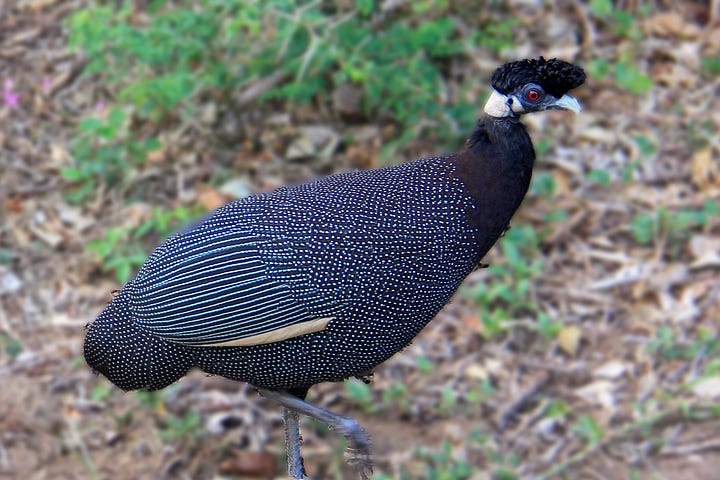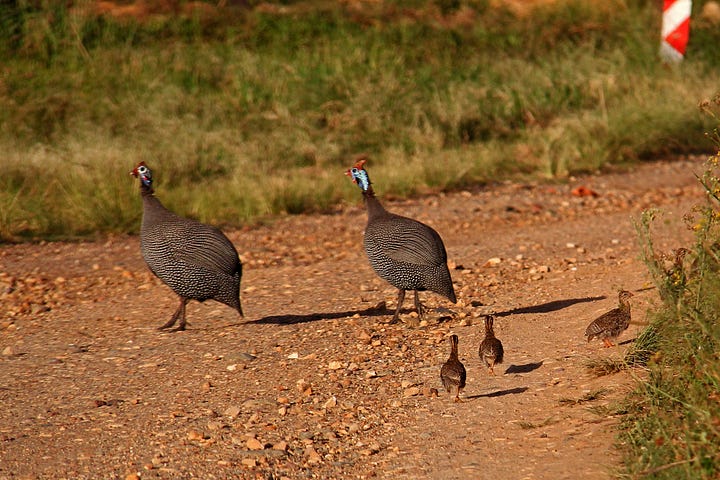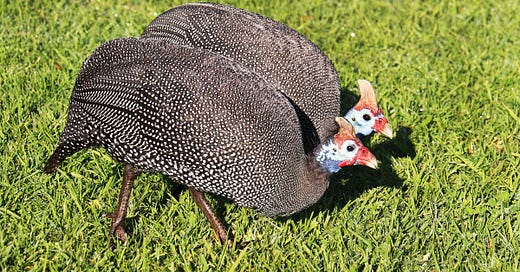Feathered Fact Tuesdays - Guinea Fowl
This month's Feathered Fact Tuesday's bird is inspired by a single feather that racked up over 1000 likes on Notes. I’m sharing fascinating facts and stories about these quirky beautiful birds.
Thank you to everyone who liked, commented, and restacked my note when I shared a photo of a beautiful Helmeted Guineafowl feather. Being relatively new to Substack, I often feel like I’m talking to myself. But after that post, I realized it’s not the case—it’s all about sharing good-quality notes and posts. So, I’ll be upping my game!
In the meantime, let’s talk about the bird behind the feather that got so much love.
Meet the Guineafowl


South Africa has two species of Guineafowl: the Crested Guineafowl (Guttera edouardi) and the Helmeted Guineafowl (Numida meleagris)
The Crested Guineafowl is the rarer of the two. With a curly mop of feathers resembling an afro and bright red eyes, they’re often called the Bob Marleys of the bush.
Helmeted Guineafowl, on the other hand, are much less selective about where they live. They roam across Africa south of the Sahara and are a common sight in South Africa, especially in open country and farmlands. But here in the Western Cape, they’ve decided suburban life suits them just fine. You’ll spot them strutting down sidewalks, hanging out in gardens, and generally treating the neighbourhood like their personal kingdom.
They’re also the only species in their family that has been introduced elsewhere in the world. You can find domesticated Helmeted Guineafowl in North and South America, India, Brazil, and Australia. I didn’t know this until I stumbled upon a small flock in the outskirts of Sydney. Interestingly, the ones I saw were much paler than their African counterparts—kind of like the sun had bleached out their vibrant colours.
Dressed to Impress
Just like the feather you admired in my note; these birds are captivating. Their plumage is a striking blue-black, covered in hundreds of tiny white spots. Their heads? Tiny and bald, topped with a bizarre helmet-like casque, giving them a permanently perplexed expression. Their faces are featherless, bright blue, and adorned with red cheek wattles, making them easy to identify.
Flight? No Thanks.
If there was an Olympic event for running away dramatically, Guineafowl would take Gold.
Despite having wings, they seem to believe flying is a last resort. Every day on my walks, I bump into these birds, usually in flocks of 10 or more. They’re quite social and will mostly ignore me—until I get too close. Then, a designated sentry will sound the alarm, and suddenly the whole flock erupts into a chaotic, out-of-tune choir of "kek-kek-kek-kraaaaaaah!"
And then? Pandemonium.
They scatter in all directions, screeching like lunatics. Maybe this is their way of confusing predators? My little dog, Lucy, who has learned not to chase birds, just watches in complete awe.
If they still feel threatened, they will finally—albeit clumsily—hurl themselves into the air, wings flapping frantically, and aim to land the nearest branch. From this safe perch, the screeching continues at full volume.
Meanwhile, Lucy has usually lost interest and moved on. I, however, am left wondering what on earth is going through their tiny, pea-sized brains.
Love and Family Life
Helmeted Guineafowl are romantics at heart and usually mate for life. They build their nests on the ground, well hidden in thick bushes, and lay up to a dozen eggs.
Their chicks, called "keets," are born with soft, downy feathers but grow their adult plumage quickly. By around eight months old, they’re fully independent.
Male Guineafowl, while generally skittish, can turn into feisty little warriors if they feel their nest or young are threatened. They’ll charge at you, yelling, of course, because that's what Guineafowl do - Yell.


The Good, the Bad, and the Noisy
Helmeted Guineafowl are classified as a species of Least Concern, which is great news. Let’s hope it stays that way. They play a useful role in the ecosystem, eating seeds, roots, insects, small invertebrates, and even ticks, helping control pests and prevent the spread of disease.
But let’s be honest—while fascinating, they can also be a bit of a nuisance.
First, they have zero respect for boundaries. They wander into streets, causing drivers to screech to a halt while they saunter across like they own the road. They invade gardens, happily uprooting your carefully planted seedlings in search of bugs. And they have no problem yelling at you—or your dog—for simply existing.
Then there’s the noise.
They chatter constantly. Loudly. At all hours.
I often wake up at night to the sound of a possible victim avoiding a hunting owl, or Grey Herons bickering over the best branch. But the early morning? That’s Guineafowl time. Around dawn, they have a full-on conference, yelling back and forth for about an hour. My question is—after talking all day, what on earth do they still have to discuss in the early hours of the morning?
A World Without Guineafowl?
For all their quirks, these birds are part of the fabric of the African landscape. They may be noisy, nosy, and a little unhinged, but the world would be poorer without them.
And after all, who else would keep us entertained with their over-the-top dramatics each day?
What Do You Think?
Have you encountered Guineafowl in your area? Do you love them, find them annoying, or both? I’d love to hear your thoughts, stories, or even your own funny encounters with these quirky birds—drop a comment below!






Oh my gosh, the babies look adorable!